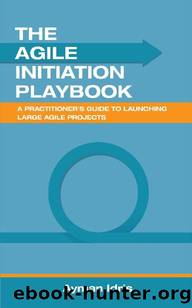The Agile Initiation Playbook: A Practitioner's Guide to Launching Large Agile Projects by Ayman Idris

Author:Ayman Idris [Idris, Ayman]
Language: eng
Format: epub
Publisher: Ayman Idris
Published: 2020-09-08T07:00:00+00:00
Activity: Wireframe refinement following customer feedback
Duration 4 hours
Difficulty
Purpose Use customer feedback to improve the MMP
Attended by Core team, business SMEs
Facilitated by UX/UI expert
After the customer-testers leave, the team gets together to digest all the insights gathered from the session. Those insights usually include commentary about what this MMP got right that the old product didnât (and vice versa), as well as a slew of ideas about what to change, minor (or major) improvements that need to be made to further improve the customer experience, etc.
The team doesnât (and shouldnât) automatically accept and incorporate every recommendation made by the customer-testers. Each recommendation should be assessed and discussed, with a cost-benefit perspective in mind and an eye on the overall business drivers/outcomes we want to achieve. For Project Rubicon, for example, our customer-testers made some recommendations that would have yielded a medium improvement in the usability of the product but with a cost, we assessed, that far outweighed the benefit. Still, many of the recommendations our customer-testers made found their way into the refined wireframes of the screens (and into how the future customer journey was refined).
After the team evaluates the insights and recommendations, they set out to iterate on the screen wireframesâled by the UX expert, but with the collaboration and support of everyone in the team. By the end of this session, we should be fairly satisfied with the refined wireframes weâve produced and with our interpretation of the future-state customer journey.
Facilitation guide
As a team, go through the insights gleaned from the prior âcustomer testingâ session. For each insight/recommendation, estimate the value that incorporating this recommendation could bring (High: implementing this recommendation could transform the user experience; Medium: implementing this recommendation would bring some value, but it isnât a game changer; Low: thereâs little value to be added by implementing this recommendation). Value here refers to the improvement of the customer experience.
Also, estimate the cost of implementing the recommendation using a similar High-Medium-Low scale (High: it would take an extraordinary effort for the team to implement this recommendation. Medium: the recommendation isnât trivial but is certainly doable. Low: this recommendation could be implemented with little effort).
Estimating the value and cost of a recommendation should give us a good idea about whether to proceed with it or not (e.g., a âlow value and high costâ recommendation is an obvious no-no). Ideally, we want to incorporate recommendations that have a low cost-to-benefit ratio.
Once the team agrees on the recommendations they want to incorporate, proceed to iterate on the wireframes (led by the UX expert with the support of the team), taking the recommendations into account.
In the end, reflect on how the refined wireframes improved upon the pre-testing ones and how easy or difficult it was to incorporate some of the recommendations made by the customer-testers as we refined the sketches/wireframes.
Download
This site does not store any files on its server. We only index and link to content provided by other sites. Please contact the content providers to delete copyright contents if any and email us, we'll remove relevant links or contents immediately.
Time Management Made Easy: How to Cultivate New Habits, Improve Productivity and Get Things Done by Joshua Strachan(2365)
The 7 Habits of Highly Effective People by Stephen R. Covey & Sean Covey(2098)
The Concise Laws of Human Nature by Robert Greene(1715)
Doesn't Hurt to Ask by Trey Gowdy(1555)
Primal Leadership by Daniel Goleman(1125)
Hook Point: How to Stand Out in a 3-Second World by Brendan Kane(1098)
HBR's 10 Must Reads 2021 by unknow(1044)
Don't Sweat the Small Stuff...and It's All Small Stuff by Richard Carlson(1014)
Amazon Unbound by Brad Stone(979)
100 Things Successful People Do by Nigel Cumberland(963)
HBR's 10 Must Reads 2021 by Harvard Business Review(956)
The Job Closer by Steve Dalton(939)
Master of One by Jordan Raynor(934)
Lives of the Stoics by Ryan Holiday & Stephen Hanselman(900)
Declutter Your Mind: A step by step guide to learn to control your thoughts, stop worrying, relieve anxiety and eliminate panic attacks and negative thinking by Mia Chandler(875)
The Power of 100! by Shaun King(844)
Conflicted by Ian Leslie(798)
Coders at Work: Reflections on the craft of programming by Peter Seibel(787)
The Book of Hope by Jane Goodall(744)
